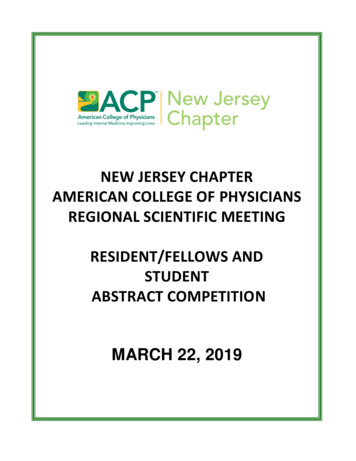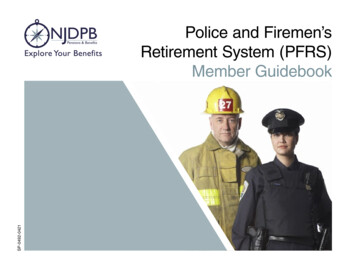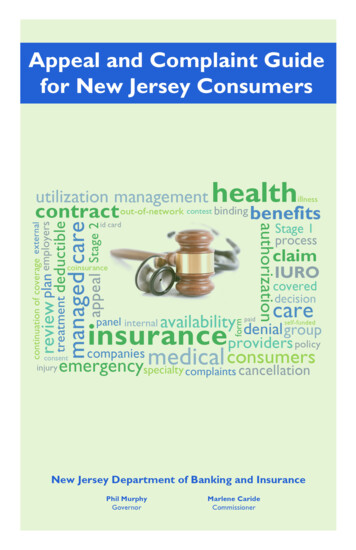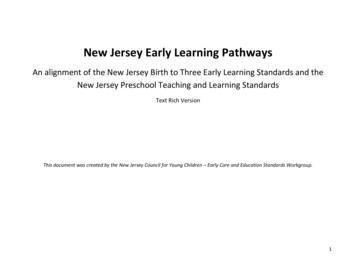
Transcription
NEW JERSEY CHAPTERAMERICAN COLLEGE OF PHYSICIANSREGIONAL SCIENTIFIC MEETINGRESIDENT/FELLOWS ANDSTUDENTABSTRACT COMPETITIONMARCH 22, 2019
PARTICIPATING INSTITUTIONSThank you to all the programs who submitted abstracts for this year’s abstract competition.Abstracts were received from the following programs:Atlanticare Regional Medical Center (Dominik Zampino, MD, FACP)Atlantic Health (Overlook) (Jeff Brensilver, MD, FACP)Capital Health Regional Medical Center (Saba Hasan, MD, FACP)Cooper University Hospital (Brian Gable, MD, FACP)Englewood Hospital and Medical Center (Karlene Williams, MD)HackensackUMC Mountainside (Bijal, Mehta, MD)HackensackUMC Palisades (Sameh Elias, MD)Jersey Shore University Medical Center (Perth Amboy/Raritan Bay) (Mayer R Ezer, MD)Jersey Shore University Medical Center (Arif Asif, MD)Monmouth Medical Center (Margaret Eng, MD, FACP)Newark Beth Israel Medical Center (Jersey City) Program (Chris Engell, MD)RowanSOM/Jefferson Health/Our Lady of Lourdes Health System Program (Judith Lightfoot, DO)Rutgers Robert Wood Johnson Medical School Program (Ranita Sharma, MD)Rutgers New Jersey Medical School Program (Mirela Feurdean, MD)Saint Barnabas Medical Center (Sunil Sapru, MD)Saint Francis Medical Center (Sara Wallach, MD, FACP)Saint Joseph's Medical Center (Muhammad A Khan, MD, FACP)St Michael's Medical Center Program (Joseph R Depasquale, MD)Saint Peter's University Hospital (Nayan Kothari, MD, MACP)Trinitas Medical Center (William Farrer, MD, FACP)2019 ACPNJ Associate Abstract CompetitionPage 2
ABSTRACT COMMITTEE MEMBERSTamie Proscia-Lieto, MD, MBA, FACP – ChairDaniel Goldsmith, MD, FACPWilliam E. Farrer, MD, FACPLou Friedman, DO, FACPMohammad Hossain, MDAdam Kaplan, MD, FACPAnand Kaji, MDDavid Kuo, MD, FACPShuvendu Sen, MDVallur Thirumavalavan, MD, FACPSara Wallach, MD, MACPDominic Zampino, DO, FACPDISCLAIMERIt is assumed that all participants adhered to the rules as stated in the original abstract submission form. It isalso assumed that the abstracts submitted were original works, represented by the true authors. The abstractsappear in no particular order. Judging was performed in an attempt to minimize bias. Judges were unaware ofthe authors unless they were directly involved with the associate. Although there were many excellent abstractsthose selected to be presented as poster or oral presentation were chosen on the basis of content. This contentwas felt to be intriguing from a clinical education standpoint, thought provoking, or could stimulate debateregarding our current practice of medicine.2019 ACPNJ Associate Abstract CompetitionPage 3
Thank You to Our Oral Abstract Presentation JudgesJon Shammash, MD, FACPMirela Feurdean, MD, FACPTamie Proscia-Lieto, MD, MBA, FACPBalaji Yegneswaran, MD, FACPA Special Thank You to Our Abstract Poster JudgesMohammad Hossain, MDGina LaCapra, MD, FACPAdam Kaplan, MD, FACPDavid Kuo, MD, FACPPayal Parikh, MDShuvendu Sen, MDBalaji Yegneswaran, MD, FACPDominic Zampino, DO, FACP2019 ACPNJ Associate Abstract CompetitionPage 4
ORAL ABSTRACT PRESENTATIONS2019 ACPNJ Associate Abstract CompetitionPage 5
Reinforcing Teamwork in a High Call Volume Step Down Unit: A Collaboration Among the Night FloatResidents, Hospitalists, NursesQuality Improvement/Patient SafetyKrizelle Garde-Jara, MD; Amulya Dakka, MD; Urmil Patel, MD; Vishal Patel, MD;Richa Dhawan, MD; Dominick Zampino, DO; Alieen Hocbo, MD; Jennifer KetchledAtlantiCare Regional Medical Center Program (Dominick Zampino, DO)BackgroundThe Progressive Care Unit (PCU) is an intermediary unit between the ICU and the general medical ward. Coverage isprovided by a dedicated Hospitalist during the day. During the hours of 7pm to 7am, coverage is provided by aNocturnist. Issues requiring immediate attention are channeled through a phone call/paging system, to the Nocturnist.In addition to the PCU, the Nocturnist is designated to respond to calls from the general medical ward, resulting in a highcall volume to responder ratio. If the nocturnist is unable to respond to the calls, the Medical Evaluation Team (MET) iscalled to bedside.IntroductionThe PCU Call Volume Project puts in place a systematic approach to preventing disruption of workflow, and interferencewith patient care stemming from large call volumes, which result in overall team dissatisfaction. An evening PCUrounding system, will be in place for the duration of the project, with the aim to reduce the number of outgoing PCUcalls/pages and MET calls during the night shift, and increase overall team satisfaction.MethodEvening PCU rounds were conducted by residents, to address anticipated areas of concern. Day and Night Shift PCUnurses filled out a 9-question survey that evaluated the efficiency of the exchange of information with physicians,response times, and issue resolution over a 9-month pre-implementation period, which were compared with responsesduring the implementation period. Responses pertaining to communication with Medical Residents and Hospitalists,teamwork between Medical Residents and Hospitalists, and support from Medical Residents and Hospitalists fall underthe umbrella of overall team satisfaction reported by the nursing staff. Data collected, including the number ofphone/MET calls to providers, and the effectiveness of team dynamics based on communication and response times,were plotted and analyzed to assess the utility of the PCU rounds.ResultsComparison of pre and post survey data demonstrated differences in overall team satisfaction. 60% of PCU Nursingreported satisfaction with response and issue resolution times post-survey, in contrast with 25% satisfaction pre-survey.A remarkable 381.9% improvement in communication between Hospitalists and Nursing was reported. A comparativeanalysis of the Pre (Oct-Apr, 2016) and Post (Oct-Apr, 2017) survey periods demonstrated a 21.7% decrease in thenumber of MET calls since the PCU evening rounds were implemented. Prior to the project taking effect, the number ofMET calls between the months of Jul-Sep 2017 and the months of Jul-Sep 2016 did not show significant change.ConclusionData indicated that the evening rounding system resulted in a reduced number of MET calls, translating to a decrease inthe number of patients that decompensated and required immediate evaluation during the night, resulting inimprovement in workflow, manpower and time utilization, and overall increase in team satisfaction.2019 ACPNJ Associate Abstract CompetitionPage 6
Carrots or Sticks - A Not so Novel Way to Dramatically increase the Immunization RateQuality Improvement/Patient SafetyRoozbeh Ghavami, MD; Aram Srapyan, MD; Saba Hasan, MD; Delaram Moazami, MD;Daniel Goldsmith, MDCapital Health Regional Medical Center Program (Saba A. Hasan, MD)BackgroundImmunization rates in adults in the United States are low, especially amongst racial and ethnic minorities and theuninsured.Resident-staffed free ambulatory clinics provide valuable healthcare access to the uninsured population, whomotherwise utilize the emergency department to seek medical care.In participation with the ACP QI champion program and i-Raise the Rates, we set out to increase immunization rates inour free ambulatory clinic community. Utilizing the PDSA and SMART model of problem solving along with RapidExperiments and Tests, we were able to improve our vaccination rates above our expectations.MethodsTo achieve our goals we initiated a series of steps to include nursing staff standing orders, daily team huddles andresident education through morning reports and noon conference series. These steps yielded a very minor increase inour immunization rates. The first PDSA cycle uncovered an issue with resident compliance as it is easy to overlookvaccination deficiencies during sick visits. We further expanded our efforts to include a Pre-Visit Chart Check List (PVCC)to ensure residents are reminded of vaccination deficiencies. We also incorporated bi-weekly random chart checks tomonitor progress of the initiatives and to identify any issues. Our observation demonstrated that even with the PVCCmany residents failed to comply with the initiative as it was not a required part of the daily routine. With collaborationof faculty and nursing staff, we made the PCVV mandatory part of the patient encounter, regardless of the reasonbehind the visit. Residents had to complete the PCVV prior to the visits and share the information with the nursing staffprior to presenting the case to the attending. If the PCVV was not completed, residents could not present the case andhad to return after completing the list.ResultsTdap vaccination volume in the cycles before the PCVV was 8.5 per month. Post-PCVV the rate was 17.5 per month, a105% increase.Pneumococcal vaccination volume in the cycles before the PCVV was 11.7 per month. Post-PCVV the rate was 14.3 permonth, a 22% increase.DiscussionWe conclude that mandatory steps are required to ensure resident/physician compliance as a means to improvevaccination rates. Incentives play an important role to ensure minimum PCVV follow up; however, mandatoryrequirements along with hard-stop checkpoints were found to be more effective.Another important aspect of PDSA cycles are their short duration. This allows mistakes and obstacles to be identifiedquickly, resulting in more rapid solutions and adaptations. Thus, carrot and stick approaches should be applied such thatboth have positive motivational effects on staff.2019 ACPNJ Associate Abstract CompetitionPage 7
Capsule Endoscopy Transit Time to Duodenum: Data to Support Safety of Shorter Interval BetweenColonoscopy Prep and ProcedureResearchDiana Curras-Martin, MD; Shreya Gor; Alsadiq AlHillan; Adaeze Ezeume; Varsha Gupta;Albino Copca-Alvarez; Arif Asif; Mordechai Bermann; Gagan Beri; Michael CarsonJersey Shore University Medical Center Program (Arif Asif, MD)BackgroundTo minimize risk of aspiration, anesthesia guidelines recommend fasting time before endoscopic procedures anesthesiapractice guidelines state that procedures may be safely performed 2 hours after ingesting fluids. The American Societyfor Gastrointestinal Endoscopy (ASGE) states that the final oral preparation liquid should be administered 3-8 hours priorto the procedure. However, at our institution some anesthesiologists will delay endoscopy cases if liquids are consumedwithin 4,6, or 8 hours before the procedure. Some will delay if the liquid was milk. Objectively documenting gastrictransit time via a review of pill endoscopy data could address clinicians concerns, prevent delays in patient care, andimprove the rate at which our clinicians practice within national guidelines. The objective was to utilize capsuleendoscopy data from our center to determine the gastric transit time (GTT) from stomach to duodenum and small boweltransit time (SBTT) in relation to patient factors such as BMI, albumin, diabetes mellitus (DM), chronic kidney disease(CKD).MethodsThis retrospective chart review obtained data on adult pill endoscopy (PillCam) studies on in- and out-patients. Pastmedical history and laboratory data was only available via the EMR only on inpatients. Mean GTT and SBTT reported inminutes S.D. Statistics: Descriptive and t-test to compare means.Results163 records reviewed. 4 patients were excluded as the pill did not pass out of the stomach. Mean age 66 years, 57%female, 26% evaluated for GI bleeding, mean hemoglobin 9.1 mg/dL 3, mean ferritin 195 395. Mean GTT Time inMinutes: All patients (n 159) 35 49, median 19, range 1-383. There were no statistically significant differences in GTTbetween the following subgroups: CKD0 (n 100) 40 58 vs. CKD5 (n 11) 35 39, Albumin 3.0 (n 123) 37 53 vs.Albumin 3.0 (n 36) 27 30, Diabetes (DM, n 40) 51 71 vs. NonDM (n 119) 42 79, BMI 30, or aspirin use. SBTT Results:All patients (n 124) 238 minutes 88. Similarly, there was no relation between SBTT and albumin, any CKD, CKD0 vsCKD5, DM status, or BMI. The ages of patients with the capsule stuck in the stomach were 61, 66, 72, and 82; and theydid not have other clinical history to explain the complication.ConclusionThis analysis of objective data regarding pill endoscopy found that the average gastric transit time was 44 minutes, for50% it was 20, and for 85% 60. We did not find that GTT was longer in those with DM, any CKD, albumin 3.0 mg%,BMI, aspirin, or CKD 5 vs. CKD0. This data supports the recommendations that endoscopic procedures, in accordancewith anesthesia and ASGE guidelines, can be safely conducted in the majority of patients within 60 minutes of ingestingliquids.2019 ACPNJ Associate Abstract CompetitionPage 8
Trimetazidine in the Prevention of Contrast-Induced Nephropathy in Patients with Renal Insufficiency:A Systematic ReviewResearchAshkan Heshmatzadeh Behzadi, MD; Shalini S. Jain, Umar Zahid, Mohamed M. Bakr;Michael J. Levitt; Arif AsifJersey Shore University Medical Center Program (Arif Asif, MD)IntroductionContrast-induced acute kidney injury (CI-AKI), is an acute impairment in renal function and it is one of the leading causesof acute kidney injury. The incidence of CIN is increasing every year, which is associated with increased patients’morbidity and mortality. Trimetazidine (TMZ) is a type of anti-ischemic drug which inhibits the excessive release ofoxygen-free radicals, increases glucose metabolism, and reduces membrane lipid peroxidation after ischemia–reperfusion. Trimetazidine has been treated as a drug with a high safety and tolerability profile that rapidly absorbed fromthe intestinal tract. Data on the renal effects showed TMZ can significantly reduce the incidence of CI-AKI. We conductedthis systematic review and meta-analysis of clinical trials that investigated the clinical effect of TMZ on prevention of CINin patients with renal insufficiency undergoing coronary angiography.MethodThis meta-analysis was conducted according to the Preferred Reporting items for Systematic Reviews and Meta-Analysesguidelines (PRISMA). A search of the Medline, Cochrane and Google Scholar databases were conducted by tworesearchers independently. The primary search for clinical trials was for clinical trials comparing TMZ versusconventional hydration for prevention of CIN through September, 2018. The outcome of interest was the incidence ofCI-AKI. The relative risk (RR) was estimated with 95% confidence interval (CI). Heterogeneity was reported with the I2statistic, using a fixed-effects model, and 50% of I2 was considered to be statistically significant. P 0.05 was consideredto indicate a statistically significant difference. All statistical analyses were performed using STATA software, V-12.0.Result1021 potentially relevant articles were compiled using the different databases. Of these, 751 articles were excludedbecause they did not meet the selection criteria on the title or abstracts. The remaining 270 results were considered tobe of relevance and full papers were carefully screened. Finally 11 studies met our inclusion/exclusion criteria for thisanalysis which included 1611 patients. Among them, 797 patients were included in the TMZ plus hydration group and814 patients in the control (hydration) group.Results of the meta-analysis showed that the heterogeneity of studies is low: I2 0%, P 0.747,. The incidence of CIN inthe TMZ plus hydration group was 6.0% (48/377) and the incidence of CIN in the hydration group was 20.6% (75/814).A pooled analysis for all studies showed that TMZ can significantly reduce the incidence of CIN-AKI compared to salinealone (relative risk 0.35, [CI 95%] 0.25, 0.48, P 0.000).ConclusionThis systematic review and meta-analysis was presented by combining data from 11 studies which showed Trimetazidinecan effectively protect renal function and reduce the incidence of CIN in patients undergoing coronary angiography. Werecommend large-scale design RCTs with long-term follow-up incorporating the evaluation of clinically patient-centeredoutcomes to confirm the robustness of our results.2019 ACPNJ Associate Abstract CompetitionPage 9
RESIDENT ABSTRACTPOSTER PRESENTATIONSRESEARCH2019 ACPNJ Associate Abstract CompetitionPage 10
A Resident-Led Initiative to Bring Teaching Back to the Bedside at a Community HospitalResearchChinelo Okigbo, MD; Pavan Ganapathiraju; Aileen Hocbo; Snigdha Kanakamedala; Amulya Dakka;Paolo Tempongko; Krizelle GardeAtlantiCare Regional Medical Center Program (Dominick Zampino, DO)BackgroundHistorically, bedside teaching is one of the most important teaching modalities in medical education. Over theyears, the prevalence of bedside teaching in residency programs has been on the decline while the prevalenceof physician burnout has been on the increase. Many have attributed the decline in time spent with patientsand increase in time spent with computers as a potential contributor to the rising physician burnout. We setout to find ways to allow residents to engage in meaningful encounters with patients at the bedside with thepotential of helping the residents find meaning in their work and training.ObjectiveTo improve the prevalence of bedside rounds and to examine the effect of bedside rounds on residents’ andfaculty’s satisfaction, burnout, and meaning-in-work.MethodsThis prospective study used a pre/post intervention design to obtain data from internal medicine residentsand faculty. The intervention was a one-time training on how to provide and engage in bedside rounds. Thesetrainings were conducted separately for residents and faculty in the first week of July 2018. Pre-interventiondata were collected between January 8 and June 28, 2018 while the post-intervention data were collectedbetween July 23 and October 19, 2018. The data collected included daily information on teaching rounds andresidents and faculty surveys on satisfaction, burnout, and meaning-in-work. The sample included 20 residentsand 12 faculty in the pre-intervention period and 29 residents and 10 faculty in the post-intervention period.ResultsTwo teaching teams were studied, one in the Mainland Campus and another one in the City Campus. Eachteaching team consisted of a faculty member, one resident, and two interns. On average, each team hadsixteen to seventeen patients with three to four new patients per day. In the pre-intervention period, therewere no bedside rounds in the City campus while one patient per day was rounded on at the bedside by theMainland team. In the post-intervention period, the number of patients with bedside rounds increased to anaverage of three patients a day in both campuses. The duration of bedside rounds per patient in bothcampuses increased from an average of twelve to fourteen minutes in the pre-intervention period to fourteento sixteen minutes in the post-intervention period. Residents’ satisfaction and meaning-in- work significantlyimproved while residents’ burnout rate significantly decreased during the study period. In contrast, the facultyhad decreased satisfaction and increased burnout rate during the study period. There was no significantdifference in the faculty’s meaning-in- work.ImplicationsBringing residents back to the patients’ bedsides not only improves their clinical skills but also has thepotential to improve their wellbeing. Thus, emphasis should be placed on meaningful engagement withpatients during residency training.2019 ACPNJ Associate Abstract CompetitionPage 11
Screening Hospitalized Patients for Obstructive Sleep ApneaResearchAnkita Patel, MD; Sarah Stuart, MD; Jay Desai, MD; George Mbolu, MD; Richard Adamczyk, PharmD;Valerie Allusson, MD, SFHM, FACP, MMM; Lopa Patel, MDHackensackUMC Mountainside Program (Bijal Mehta, MD)BackgroundObstructive sleep apnea (OSA) is a disorder that is characterized by obstructive apneas and hypopneas due torepetitive collapse of the upper airway during sleep. OSA is the most common sleep-related breathingdisorder. Prevalence estimates vary according to the way in which OSA is defined and the distribution of riskfactors in the population being studied. The estimated prevalence in North America is 20 to 30 percent inmales and 10 to 15 percent in females when OSA is defined broadly. Patients with OSA, particularly when it ismoderate or severe and untreated, are at increased risk for a broad range of cardiovascular morbidities,including systemic hypertension, pulmonary arterial hypertension, coronary artery disease, cardiacarrhythmias, heart failure, and stroke. STOP BANG questionnaire is the most validated tool for screening.PurposeThe study was interested in screening hospitalized patients at risk for underlying undiagnosed sleep apnea.Patients on select floors were screened using the STOP BANG survey. The study was interested in seeing howmany patients fall into intermediate and high risk. A secondary goal was to educate intermediate and high riskpatients regarding OSA and to have them follow up with outpatient physician for further evaluation.MethodsA member of the hospital quality team, screened patients on select floors in the hospital. The patients weregiven the option to be screened or not. Screening was completed using STOP BANG. Patients who scoredintermediate or high risk, were informed of their score. These patients were given a brochure on obstructivesleep apnea, education by a respiratory therapy, and instruction to follow up with their physician outpatientfor further evaluation.Data AnalysisEach patient was scored using the STOP BANG survey. Patients who scored 0 to 2 were low risk. Patients whoscored 3 to 4 were intermediate risk and patients who scored greater than 5 were high risk. The total numberof patients who scored low risk, intermediate risk and high risk was then totaled. Percentages were calculatedfor each of the three groups. The study found (92/276) 33% scored low risk; (102/276) 37% scoredintermediate risk; (82/276) 67% scored high risk. Therefore, (184/276) 67% of the patients scoredintermediate to high risk for underlying sleep apnea.ConclusionA majority of hospitalized patients, 67%, screened within intermediate/high risk using STOP BANG. Inparticular, these patients are at increased risk for cardiovascular events including, cardiac arrhythmias,congestive heart failure, hypertension, and cardiomyopathy. Other consequences of untreated sleep apneainclude diabetes, depression, chronic fatigue, hypersomnia, memory loss, sexual dysfunction and stroke.These results will lead to a hospital wide intervention to screen all hospitalized patients in an effort to begintreating these individuals.2019 ACPNJ Associate Abstract CompetitionPage 12
Prevalence of Obesity in Hospitalized Adult Patients: A Retrospective Cohort StudyResearchShreya Gor, MD; Ami Amin, MD; Anju Paul, MD; Huzaif Qaisar, MD; Monika Akula, MD; Alireza Amirpour, MD;Mohammad A. Hossain, MD; Arif Asif MD, MHCMJersey Shore University Medical Center Program (Arif Asif, MD)BackgroundWhile obesity is a serious chronic condition, its prevalence and documentation as a diagnosis has not beenextensively studied in hospitalized patients. We conducted a retrospective chart review to investigate theprevalence and documentation of obesity as a diagnosis among patients admitted to our medical center.Method: All consecutive patients admitted to inpatient medical floor during a 60-day period from Septemberthrough October 2017 were selected for the study. The following information was abstracted from the charts:Patient demographics including Body mass index (BMI), admission/discharge note with obesity as one of thediagnoses, common medical comorbidities (hypertension, diabetes, hyperlipidemia, coronary artery disease,congestive heart disease, chronic kidney disease, chronic obstructive pulmonary disease), and length of stay.Obesity was categorized per the CDC guidelines as: normal weight (BMI 18–24.9 kg/m2), overweight (BMI 25–29.9 kg/m2) and obese (BMI 30 kg/m2). The obese group was further divided into 3 classes. Class I (BMI 30–34 kg/m2), Class II (BMI 35–39.9 kg/m2) and Class III (BMI 40 kg/m2).We also reviewed charts regardingdocumentation of counselling to the obese patients for weight loss.ResultsA total of 540 consecutive charts were reviewed. The mean age was 66 6 years. Out of 540 patients only182(34%) had normal weight, 188(35%) were overweight and 170(31%) were obese. In the obese group, 55%were female. 100(59%) had class I obesity, 43(25%) had class II obesity and 27(16%) class III obesity. Obesitywas documented on the admission problem list in 40/170(23.5%) patients and only 21(12%) had obesitydocumented as a discharge diagnosis.3 (2%) patients were given appropriate obesity and weight reductionrelated counseling and referral during the hospitalization. Comorbidities and their prevalence included,hypertension (68%), diabetes (35%), hyperlipidemia (36%), coronary artery disease (18%), chronic kidneydisease (17%), congestive heart failure (18%) and COPD (24%). The average length of stay regardless of BMIgroup was 4.5 0.5 days.ConclusionA significant number of hospitalized patients were overweight and obese. An overwhelming percentage neverhad weight status documented. Hospitalization offers health care providers a window of opportunity toidentify obesity, communicate risks and initiate weight management interventions.2019 ACPNJ Associate Abstract CompetitionPage 13
The Perspective of a Breast Cancer Patient: A Survey Study Assessing Needs and ExpectationsResearchMuhammad Sardar, MD; Nasreen Shaikh; Wahab Jahangir khan; Hafiz Ghaffar Khan; Sindhura Inkollu;Amulya Prakash; David Sharon; Shira GoldbergMonmouth Medical Center Program (Margaret H Eng, MD)BackgroundPatient satisfaction is one of the key indicators of health care quality. We aim to identify patients’ needs andexpectations to achieve a patient centered care and better overall satisfaction.MethodA 17-item survey was administered to 49 patients at a breast cancer clinic. The survey was designed after athorough literature review and approved by an oncologist and a palliative care physician.ResultsSelf-reported knowledge about disease was reported adequate by 95.9% of our patients yet only 46.9% of ourpatients could identify the stage of their cancer. More education was desired by 39% of patients includingvarious treatment options (35%), common complications (29%), prognosis (22%) and risk factors (14%). Cancerrelated emotional stress, physical symptoms and effect on social/professional life was reported by 53%, 53%and 49% of our patients respectively. Majority of our patients (57%) wanted their oncologist to address social/emotional issues and 28% felt the need of more focus on physical symptoms in their subsequent visits. End oflife care (EoLC) discussions were considered an integral component of overall care by 22% of our patients.Components of EoLC discussions that patients stated they could benefit from included prognosis (24.5%), lifeexpectancy (24.5%), treatment effect on QoL (20.4%), palliative care (10.2%), hospice (10.2%), advancedirectives (14.3%) and family involvement in medical decision making (12.2%). More patients wanted toinitiate EoLC discussions when they requested it (30.6%) or their oncologist thought it was appropriate (30.6%)as compared to when it may change treatment course (12.2%) or at diagnosis (8.2%). More patients wantedhaving EoLC discussions only once (40.8%) as compared to at regular intervals (32.7%)ConclusionA discrepancy between self-reported and actual knowledge in breast cancer patients emphasizes the need ofpatient education. Most patients rely on their oncologist for their diagnosis related emotional and socialissues. Surprisingly, a quarter of our patients consider EoLC discussions important even though majority of ourpatients were healthy and having stage I disease.2019 ACPNJ Associate Abstract CompetitionPage 14
Autoimmune Hepatitis and Extra-Hepatic Autoimmune Disease: A Nationwide StudyResearchAlana Persaud, MD; Yasaman Motlaghzadeh and Sima VossoughRutgers New Jersey Medical School Program (Mirela Feurdean, MD)BackgroundAutoimmune hepatitis (AIH) is a chronic hepatitis that is caused by a reaction towards the body’s endogenousliver enzymes. Extra-hepatic manifestations are said to present in 20% of cases and may occur either beforeonset of disease or during the clinical course. However, the relationship that exists between AIH and extrahepatic autoimmune disease (EHAID) has not been fully defined and it is suggested that different autoimmuneconditions affect AIH differently. Indeed, this association as well as the increased incidence of depression seenin this cohort are enough impetus to warrant further examination. The aim of this study is to observe thenational trends in AIH hospitalizations while examining the relationship with concurrent autoimmunedisorders.MethodsThe National Inpatient Sample (NIS) is the largest all-payer inpatient database consisting of approximately 20%of all inpatient admissions to nonfederal hospitals in the United States. We collected data from years 2012 –2014. Cases of AIH and other autoimmune conditions as secondary diagnoses were identified using theInternational Classification of Diseases, 9th Edition, Clinical Modification (ICD-9 CM). Percentages of AIHpatients affected by at least one other EHAID, as well as length of stay (LOS), cost of admission, and mortalitywere evaluated and adjusted for comorbidities.ResultsBetween 2012 - 2014, there were 11,270 cases of AIH identified. Approximately 22% of patients had at leastone EHAID, with most affected by hypothyroidism, lupus, and rheumatoid arthritis. However, those withadditional autoimmune conditions had a decreased LOS as compared to those with just an AIH diagnosis (4.81days vs. 5.61 days, p 0.001). Mortality rate was also decreased, with 0.97% in those with EHAID and 2.8%mortality in those with just AIH (p 0.001). 33.1% of the total population had a severe Charlson score whichcomprised 29.6% of the AIH population and 44
Comparison of pre and post survey data demonstrated differences in overall team satisfaction. 60% of PCU Nursing reported satisfaction with response and issue resolution times post-survey, in contrast with 25% satisfaction pre-survey. A remarkable 381.9% improvement in communication between Hospitalists and Nursing was reported. A comparative











